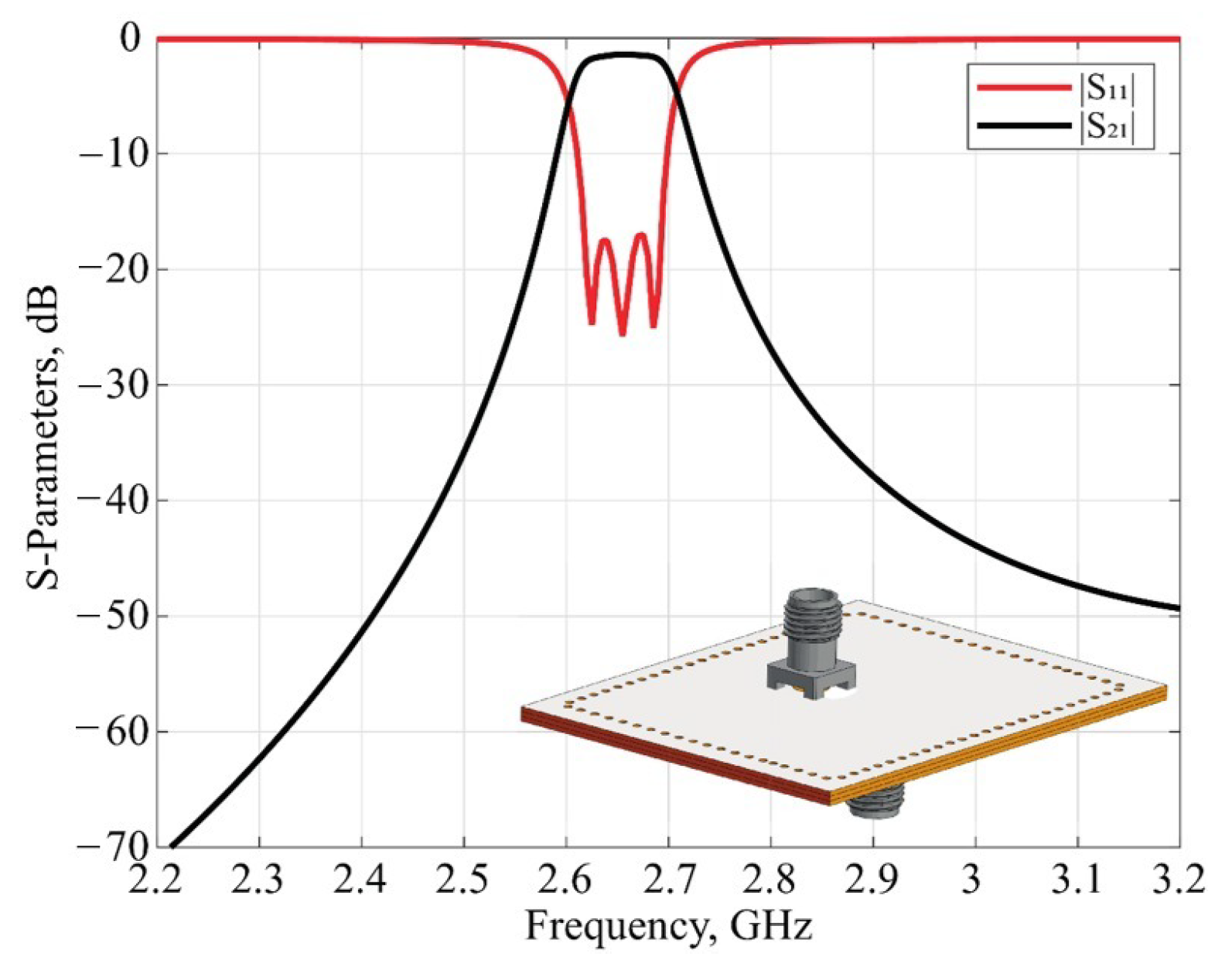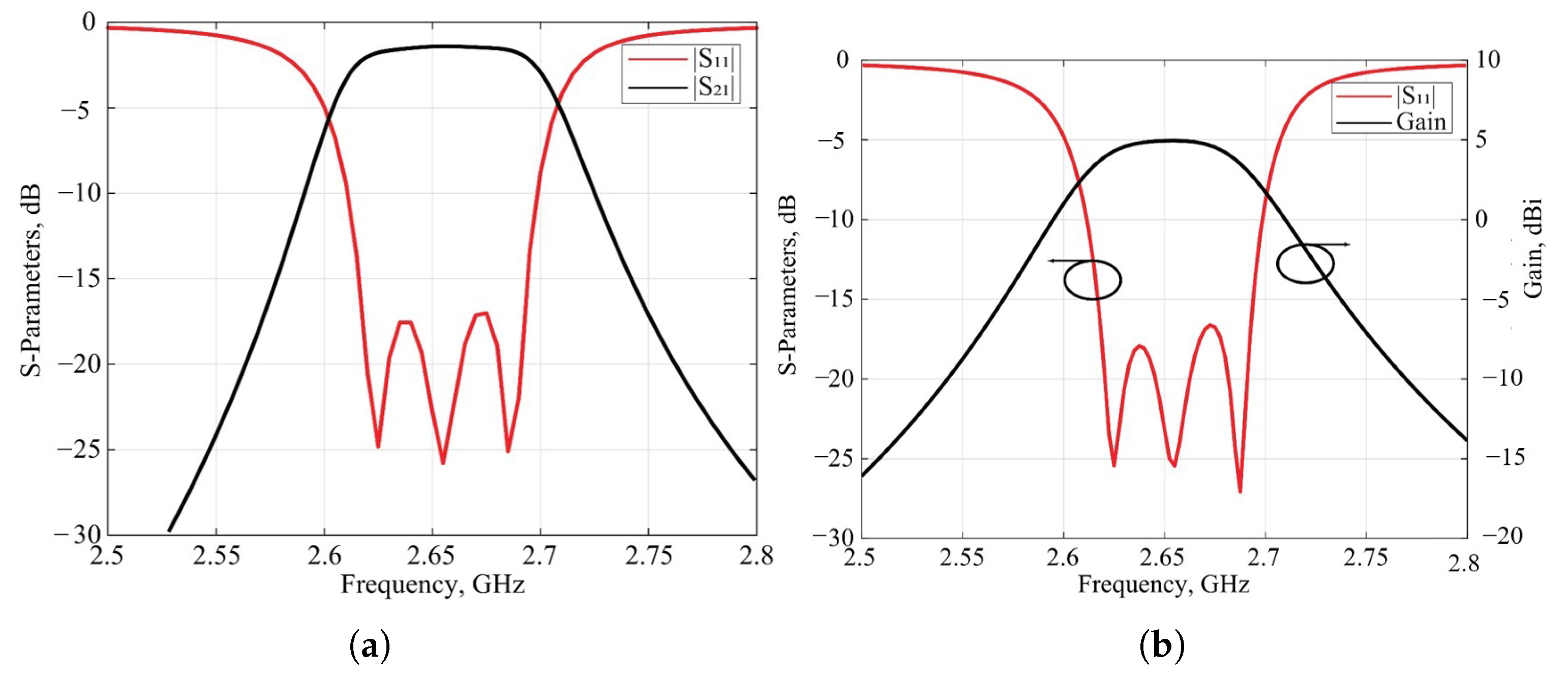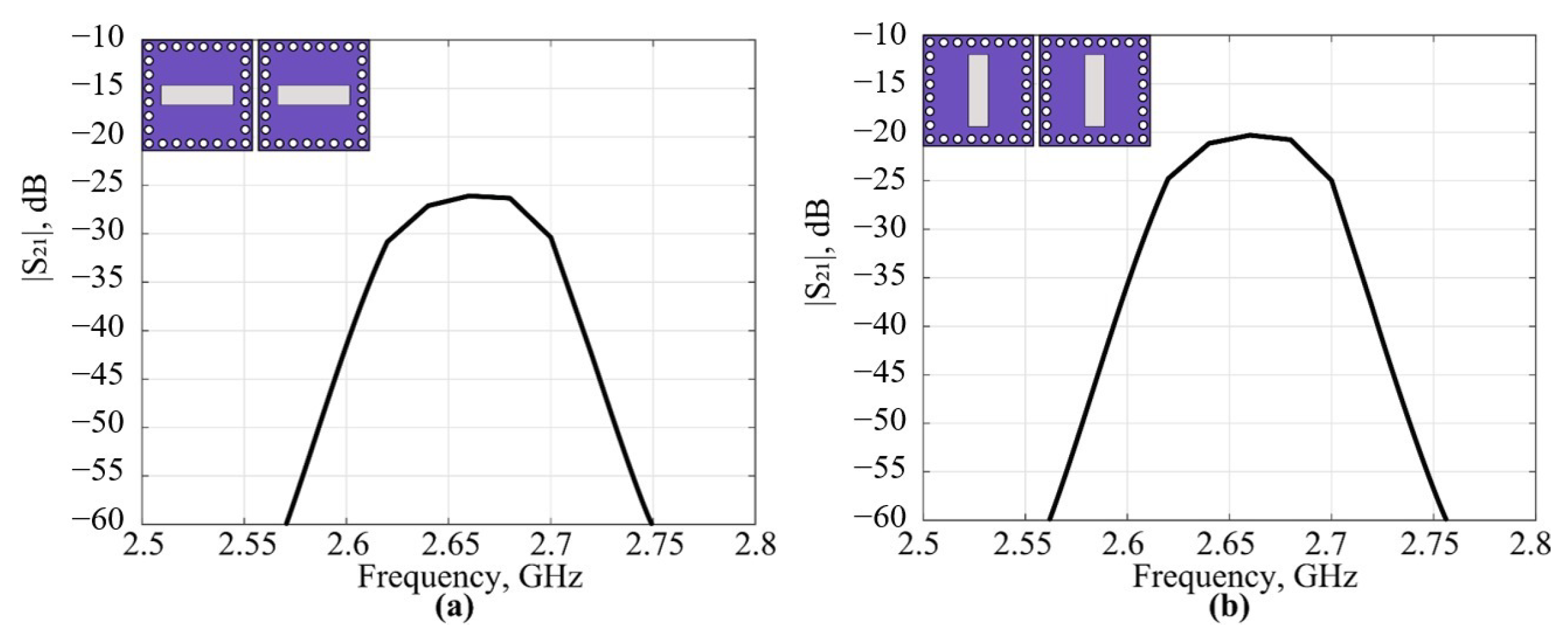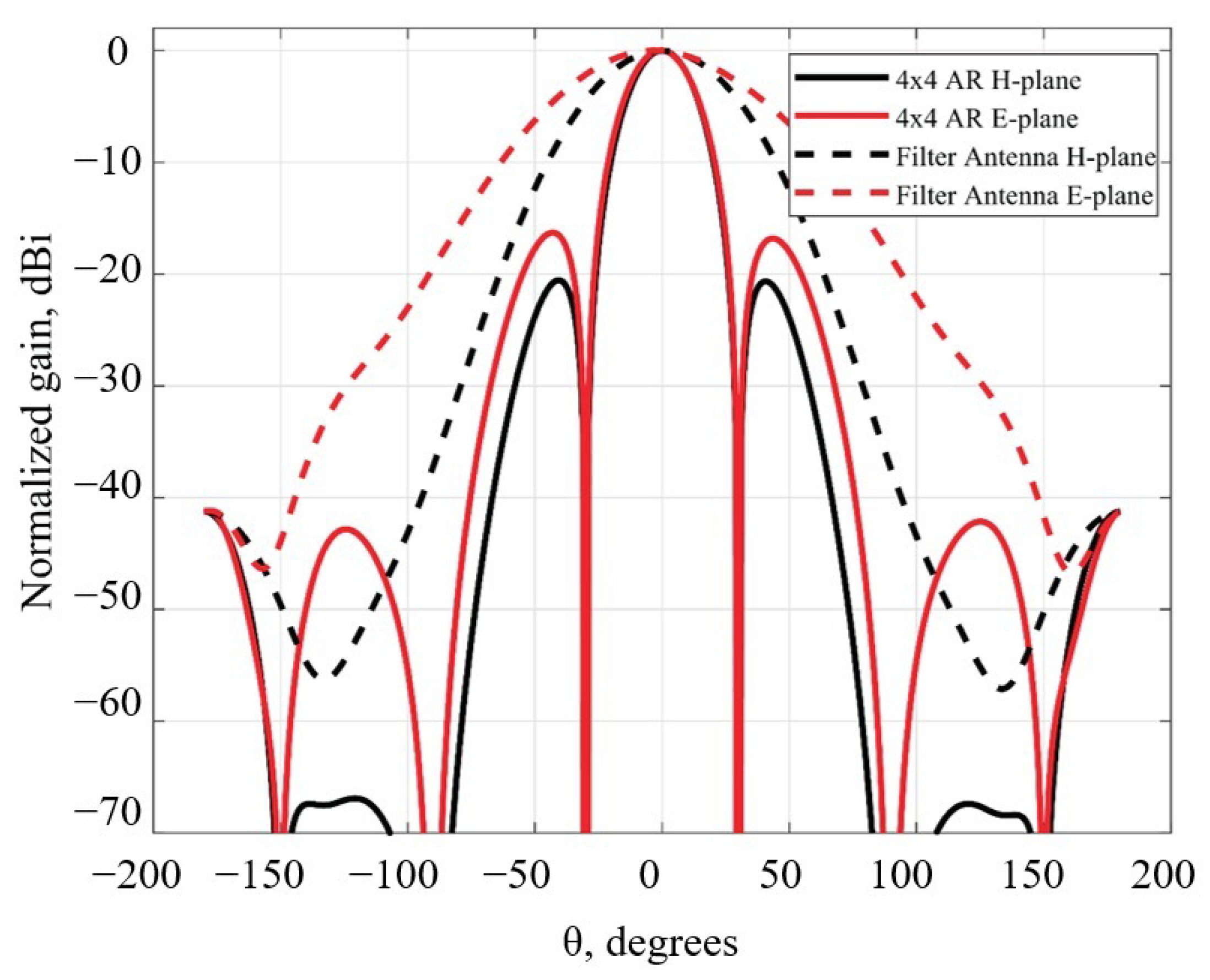Design of a Compact Unified SIW Cavity Filtenna Module for Antenna Array Application †
Abstract
1. Introduction
2. Calculation of Microwave Filter Parameters
3. Design of Filtenna
4. Experimental Results
5. Conclusions
Author Contributions
Funding
Data Availability Statement
Conflicts of Interest
References
- Dhillon, A.S.; Radi, B.; Liboiron-Ladouceur, O. An Analysis of RF On-Chip Antennas in Si-Based Integrated Microwave Photonics. IEEE Photonics J. 2021, 13, 1–18. [Google Scholar] [CrossRef]
- Nallandhigal, S.N.; Burasa, P.; Wu, K. Deep Integration and Topological Cohabitation of Active Circuits and Antennas for Power Amplification and Radiation in Standard CMOS. IEEE Trans. Microw. Theory Tech. 2020, 68, 4405–4423. [Google Scholar] [CrossRef]
- Hedayati, M.K.; Abdipour, A.; Sarraf Shirazi, R.; Ammann, M.J.; John, M.; Cetintepe, C.; Staszewski, R.B. Challenges in On-Chip Antenna Design and Integration with RF Receiver Front-End Circuitry in Nanoscale CMOS for 5G Communication Systems. IEEE Access 2019, 7, 43190–43204. [Google Scholar] [CrossRef]
- Burasa, P.; Djerafi, T.; Wu, K. A 28 GHz and 60 GHz Dual-Band On-Chip Antenna for 5G-Compatible IoT-Served Sensors in Standard CMOS Process. IEEE Trans. Antennas Propag. 2021, 69, 2940–2945. [Google Scholar] [CrossRef]
- Liu, X.; Zhang, W.; Hao, D.; Liu, Y. Differential-Fed Magneto-Electric Dipole Antenna with Integrated Balun Based on Ball Grid Array Packaging. IEEE Trans. Components Packag. Manuf. Technol. 2022, 12, 981–987. [Google Scholar] [CrossRef]
- Ma, L.; Lai, J.; Yin, Y.; Xia, C.; Gu, C.; Mao, J. A Wideband Co-Linearly Polarized Full-Duplex Antenna-in-Package with High Isolation for Integrated Sensing and Communication. IEEE Antennas Wirel. Propag. Lett. 2023, 22, 2185–2189. [Google Scholar] [CrossRef]
- Nallandhigal, S.N.; Wu, K. Unified and Integrated Circuit Antenna in Front End—A Proof of Concept. IEEE Trans. Microw. Theory Tech. 2019, 67, 347–364. [Google Scholar] [CrossRef]
- Du, Z.X.; Cui, M.; Zhang, Y.; Guo, C.; Zhang, G.; Zhang, X.Y. Compact and Scalable Active-Integrated Antenna System with Both Oscillation and Amplification Characteristics for High-Power Applications. IEEE Trans. Antennas Propag. 2023, 71, 7673–7678. [Google Scholar] [CrossRef]
- El Ouadi, Z.; Amadid, J.; Khabba, A.; El Yassini, A.; Ibnyaich, S.; Zeroual, A. Compact microstrip filtenna designed for wireless local area network applications. In Proceedings of the 2022 International Conference on Decision Aid Sciences and Applications (DASA), Chiangrai, Thailand, 23–25 March 2022; IEEE: Piscataway, NJ, USA, 2022; pp. 1593–1597. [Google Scholar]
- Wang, C.; Wang, X.; Liu, H.; Chen, Z.; Han, Z. Substrate integrated waveguide filtenna with two controllable radiation nulls. IEEE Access 2020, 8, 120019–120024. [Google Scholar] [CrossRef]
- Zheng, Z.; Li, D.; Tan, X.; Chen, Q. Single-layer dual-/tri-band SIW filtenna based on multifunctional cavity-backed slots. IEEE Trans. Antennas Propag. 2023, 71, 4498–4503. [Google Scholar] [CrossRef]
- Balalem, A.; Machac, J.; Omar, A. Microstrip-CPW bandpass filter for antenna application. Microw. Opt. Technol. Lett. 2008, 50, 51–55. [Google Scholar] [CrossRef]
- Chen, Y.; Zhou, Y. Design of a filter-antenna subsystem for UWB communications. In Proceedings of the 2009 3rd IEEE International Symposium on Microwave, Antenna, Propagation and EMC Technologies for Wireless Communications, Beijing, China, 27–29 October 2009; IEEE: Piscataway, NJ, USA, 2009; pp. 593–595. [Google Scholar]
- Chuang, C.T.; Chung, S.J. Synthesis and design of a new printed filtering antenna. IEEE Trans. Antennas Propag. 2011, 59, 1036–1042. [Google Scholar] [CrossRef]
- Yin, J.Y.; Bai, T.L.; Deng, J.Y.; Ren, J.; Sun, D.; Zhang, Y.; Guo, L.X. Wideband single-layer substrate integrated waveguide filtering antenna with U-shaped slots. IEEE Antennas Wirel. Propag. Lett. 2021, 20, 1726–1730. [Google Scholar] [CrossRef]
- Yusuf, Y.; Gong, X. Compact low-loss integration of high-Q3-D filters with highly efficient antennas. IEEE Trans. Microw. Theory Tech. 2011, 59, 857–865. [Google Scholar] [CrossRef]
- Yusuf, Y.; Gong, X. Integrated filter/antennas with high efficiency and increased bandwidth. In Proceedings of the WAMICON 2011 Conference Proceedings, Clearwater Beach, FL, USA, 18–19 April 2011; IEEE: Piscataway, NJ, USA, 2011; pp. 1–4. [Google Scholar]
- Li, P.K.; You, C.J.; Yu, H.F.; Li, X.; Yang, Y.W.; Deng, J.H. Codesigned High-Efficiency Single-Layered Substrate Integrated Waveguide Filtering Antenna with a Controllable Radiation Null. IEEE Antennas Wirel. Propag. Lett. 2018, 17, 295–298. [Google Scholar] [CrossRef]
- Hu, K.Z.; Wu, X.F.; Huang, H.Y.; Li, D.; Chen, Z.; Yan, D. A Low-Profile Single-Layer Differentially Fed Circularly Polarized Filtenna with Intrinsic Common-Mode Rejection. IEEE Antennas Wirel. Propag. Lett. 2024, 23, 3028–3032. [Google Scholar] [CrossRef]
- Liu, Q.; Zhu, L.; Wang, J.; Wu, W. A Wideband Patch and SIW Cavity Hybrid Antenna with Filtering Response. IEEE Antennas Wirel. Propag. Lett. 2020, 19, 836–840. [Google Scholar] [CrossRef]
- Zhang, Y.; Zhang, X.Y.; Liu, Q.H. A dual-layer filtering SIW slot antenna utilizing double slot coupling scheme. IEEE Antennas Wirel. Propag. Lett. 2021, 20, 1073–1077. [Google Scholar] [CrossRef]
- Yusuf, Y.; Cheng, H.; Gong, X. A seamless integration of 3-D vertical filters with highly efficient slot antennas. IEEE Trans. Antennas Propag. 2011, 59, 4016–4022. [Google Scholar] [CrossRef]
- Cheng, H.; Yusuf, Y.; Gong, X. Vertically integrated three-pole filter/antennas for array applications. IEEE Antennas Wirel. Propag. Lett. 2011, 10, 278–281. [Google Scholar] [CrossRef]
- Guo, B.C.; Hu, K.Z.; Yan, D.; Pan, S.Y.; Tang, M.C.; Wang, P. Design of compact dual-band substrate integrated waveguide filtenna. Microw. Opt. Technol. Lett. 2022, 64, 1070–1076. [Google Scholar] [CrossRef]
- Zhao, D.; Lin, F.; Sun, H.; Zhang, X.Y. A Miniaturized Dual-Band SIW Filtering Antenna with Improved Out-of-Band Suppression. IEEE Trans. Antennas Propag. 2022, 70, 126–134. [Google Scholar] [CrossRef]
- Xie, H.Y.; Wu, B.; Wang, Y.L.; Fan, C.; Chen, J.Z.; Su, T. Wideband SIW Filtering Antenna with Controllable Radiation Nulls Using Dual-Mode Cavities. IEEE Antennas Wirel. Propag. Lett. 2021, 20, 1799–1803. [Google Scholar] [CrossRef]
- Mao, C.X.; Zhang, Y.; Zhang, X.Y.; Xiao, P.; Wang, Y.; Gao, S. Filtering antennas: Design methods and recent developments. IEEE Microw. Mag. 2021, 22, 52–63. [Google Scholar] [CrossRef]
- Meyer, E.; Vertegaal, C.; Johnson, L.; Meyer, P.; Johannsen, U. Substrate Integrated Waveguide Pedestal Filtenna for Sub-6 GHz 5G Radio Frequency Front-Ends. In Proceedings of the 2022 16th European Conference on Antennas and Propagation (EuCAP), Madrid, Spain, 27 March–1 April 2022; pp. 1–5. [Google Scholar] [CrossRef]
- Luo, Y.; Yin, T.; Yan, N.; An, W.; Ma, K. A Low-Cost Differentially Fed Dual-Mode Filtering MIMO Antenna with Enhanced Isolation Based on SISL Platform. IEEE Antennas Wirel. Propag. Lett. 2022, 21, 198–202. [Google Scholar] [CrossRef]
- Sosunov, A.; Legkova, T.; Spetsakova, D.; Altynnikov, A. Antenna Module with Integrated SIW Passband Filter for Application in Communication Systems. In Proceedings of the 2024 International Conference on Electrical Engineering and Photonics (EExPolytech), Saint Petersburg, Russia, 17–18 October 2024; pp. 52–55. [Google Scholar] [CrossRef]
- Cameron, R.J.; Kudsia, C.M.; Mansour, R.R. Microwave Filters for Communication Systems: Fundamentals, Design, and Applications; John Wiley & Sons: Hoboken, NJ, USA, 2018. [Google Scholar]
- Deslandes, D.; Wu, K. Design consideration and performance analysis of substrate integrated waveguide components. In Proceedings of the 2002 32nd European Microwave Conference, Milan, Italy, 23–26 September 2002; IEEE: Piscataway, NJ, USA, 2002; pp. 1–4. [Google Scholar]
- Han, S.; Wang, X.L.; Fan, Y.; Yang, Z.; He, Z. The generalized Chebyshev substrate integrated waveguide diplexer. Prog. Electromagn. Res. 2007, 73, 29–38. [Google Scholar] [CrossRef]
- Dunsmore, J. Tuning band pass filters in the time domain. In Proceedings of the 1999 IEEE MTT-S International Microwave Symposium Digest (Cat. No. 99CH36282), Anaheim, CA, USA, 13–19 June 1999; IEEE: Piscataway, NJ, USA, 1999; Volume 3, pp. 1351–1354. [Google Scholar]
- Sukhoy, V.; Stoytchev, A. Generalizing the inverse FFT off the unit circle. Sci. Rep. 2019, 9, 14443. [Google Scholar] [CrossRef] [PubMed]
- Gagarin, A.; Tsyganova, D.; Altynnikov, A.; Komlev, A.; Platonov, R. An Adaptation of the Split-Cylinder Resonator Method for Measuring the Microwave Properties of Thin Ferroelectric Films in a “Thin Film—Substrate” Structure. Sensors 2024, 24, 755. [Google Scholar] [CrossRef]
- Choi, J.; Kim, J.; Ji, Y.; Lee, S.; Lee, J.; Yu, B.; Park, S.; Kim, M.; Jung, K.Y. SIW-Fed Patch Array Filtenna with Significant Suppression of Adjacent 5G Spectrum for Radio Altimeters. IEEE Access 2023, 11, 135846–135854. [Google Scholar] [CrossRef]
- Li, T.; Gong, X. Vertical Integration of High-Q Filter with Circularly Polarized Patch Antenna with Enhanced Impedance-Axial Ratio Bandwidth. IEEE Trans. Microw. Theory Tech. 2018, 66, 3119–3128. [Google Scholar] [CrossRef]
- Hu, K.Z.; Yuan, K.H.; Li, D.; Tang, M.C.; Chen, Z.; Yan, D. A Single-Layer Differentially Fed Filtenna with Controllable Radiation Nulls Using Hybrid SIW Cavity and Patches. IEEE Antennas Wirel. Propag. Lett. 2024, 23, 2286–2290. [Google Scholar] [CrossRef]













| mm | mm | mm | mm | mm | mm | mm | mm | mm | mm |
|---|---|---|---|---|---|---|---|---|---|
| 38.15 | 36.84 | 4.5 | 2 | 47.8 | 3 | 8.96 | 4.22 | 1.27 | 0.5 |
| mm | mm | mm | mm | mm | mm | mm | mm | mm |
| 38.84 | 37.03 | 30.21 | 14.7 | 2 | 2 | 6.48 | 6.4 | 6.31 |
| mm | mm | mm | mm | mm | mm | mm | mm | |
| 46 | 4 | 2.1 | 0.5 | 48.8 | 3 | 2 | 3 |
| Ref. No | Volume × , | Central Frequency, GHz | Bandwidth, % | Gain, dB | Radiator Type | Feed Line |
|---|---|---|---|---|---|---|
| [18] | 47.41 | ~4.4 | 5.4 | 6.5 | Slot | Coaxial |
| [20] | 20 | 3.5 | 9.14 | Slot | Microstrip | |
| [26] | 14.25 | 5.365 | 7.64 | 5.3 | Slot | Microstrip |
| [24] | 5.33 | 15.23 | 2.822 | 4.006 | 2.1 | 4.1 | 4.9 | 5.38 | Slot | Microstrip |
| [25] | 26 | 39 | 3.59 | 4.11 | 2.3 | 1.6 | 4.84 | 4.85 | Slot | Coaxial |
| [28] | 5 | 3.64 | 4.29 | 3.66 | Patch | Microstrip |
| [39] | 15.36 | 4.88 | 9 | 7.7 | Patch | Coaxial |
| [19] | 18.8 | 4.8 | 8.3 | 10 | Slot | Coaxial |
| This work | 4.5 | 2.655 | 2.64 | 3.64 | Slot | Coaxial |
Disclaimer/Publisher’s Note: The statements, opinions and data contained in all publications are solely those of the individual author(s) and contributor(s) and not of MDPI and/or the editor(s). MDPI and/or the editor(s) disclaim responsibility for any injury to people or property resulting from any ideas, methods, instructions or products referred to in the content. |
© 2025 by the authors. Licensee MDPI, Basel, Switzerland. This article is an open access article distributed under the terms and conditions of the Creative Commons Attribution (CC BY) license (https://creativecommons.org/licenses/by/4.0/).
Share and Cite
Altynnikov, A.; Platonov, R.; Sosunov, A.; Legkova, T.; Komlev, A.; Kozyrev, A.B. Design of a Compact Unified SIW Cavity Filtenna Module for Antenna Array Application. Micromachines 2025, 16, 285. https://doi.org/10.3390/mi16030285
Altynnikov A, Platonov R, Sosunov A, Legkova T, Komlev A, Kozyrev AB. Design of a Compact Unified SIW Cavity Filtenna Module for Antenna Array Application. Micromachines. 2025; 16(3):285. https://doi.org/10.3390/mi16030285
Chicago/Turabian StyleAltynnikov, Andrey, Roman Platonov, Alexey Sosunov, Tatyana Legkova, Andrey Komlev, and Andrey B. Kozyrev. 2025. "Design of a Compact Unified SIW Cavity Filtenna Module for Antenna Array Application" Micromachines 16, no. 3: 285. https://doi.org/10.3390/mi16030285
APA StyleAltynnikov, A., Platonov, R., Sosunov, A., Legkova, T., Komlev, A., & Kozyrev, A. B. (2025). Design of a Compact Unified SIW Cavity Filtenna Module for Antenna Array Application. Micromachines, 16(3), 285. https://doi.org/10.3390/mi16030285







